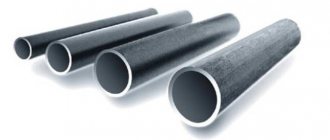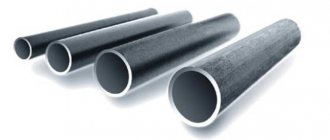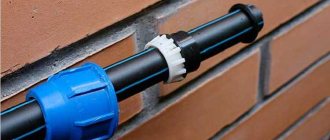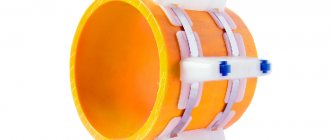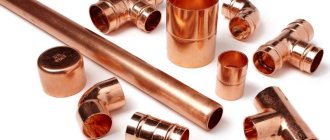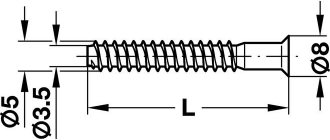Drill pipe is a long hollow object, round or square profile of various diameters, intended for arranging a drill string.
Pipes for drilling rigs are a multifunctional device and, in addition to the above functions, perform the following types of operations:
- Destruction of rock and soil.
- Lowering and raising the soil of the destructive nozzle (drill).
- Supplying special drilling fluids or compressed air (depending on the type of drilling) to the drilling site (to the point of contact between the drill bit and the soil).
- Transmission of the torque supplied to the pipe from the downhole motor through the rotor directly to the drill bit.
- Creating, strengthening and maintaining horizontal axial load to ensure proper operation of drilling equipment.
- Pumping (withdrawal) of water (oil, gas) from a well.
Also, to strengthen the internal walls of the well, in order to prevent blockages, drill casing pipes are used.
Technical device of drill pipe
The drill pipe design consists of three main parts:
- pipe bodies,
- end lock nipple,
- end lock coupling.
The named locking parts are attached by welding or threading at its opposite ends. And they are used for sequential connection of individual pipes into a single system, into the so-called drill stand.
The reliability of the pipe connection is ensured by the internal thread on the nipple and the external thread on the locking coupling. Drilling and casing pipes are used not only for industrial oil and gas production in large fields, but also in geological exploration and the national economy (drilling and lifting water from artesian wells). To arrange an autonomous water supply for dacha (suburban) areas through, again, drilling wells.
Information abstracted from the main topic. Starting with the coming New Year, drilling wells on citizens’ personal land plots, which was previously free. Taxable and punishable by law, a crime. All wells, both existing and new, are subject to mandatory state licensing.
Other types of drill pipes
In addition to the above, there are other types of pipes for drilling. For example, there is a type in which the locks are screwed onto the part. The ends of such products can extend outward or inward. Their length ranges from 6 to 11.5 m. They are always marked “TBVK” if the planting goes inside, and “TBNK” if it goes outside.
Another type of pipe that is worth mentioning are parts with welded ends. They are used when passing through difficult types of rock.
The development of drilling devices does not stand still and in the future new types of pipes will certainly be invented, the functional characteristics of which will be much higher than those of the current ones. Today, existing types of drill pipes have all the necessary properties for effective work in the mining industry.
Classification of drilling (casing) pipes for drilling rigs
Being one of the main components of a drilling rig, which is a complex technical and technological complex, drill pipes (hereinafter referred to as DP) are classified into the following groups:
Conventional BT, made of steel according to state standards (GOST) or aluminum alloys. This type of pipe has a round cross-section with a wall thickness from 7.5 (minimum value) to 11 millimeters. The connection of individual pipe fragments into a candle is carried out through a drill joint with a large threaded cone. To increase the reliability and strength of connections, the ends of the BT have thickenings.
Leading drill pipes. The top of the drill string. Transmitting torque from the engine through a special system of parts and mechanisms, the entire drill rod and directly to the drill bit. With a multifaceted pipe cross-section, the thickness of its walls varies from 23.5 mm to 89.5 millimeters. The ends of the leading BT are thickened with combined or internal (external) landings.
Weighted drill pipes. The lower part of the drill string has a round or square profile. With wall thicknesses from 16 to more than 50 mm. It increases the rigidity of the compressed parts of the drill string and transfers the load necessary to destroy the oncoming rock to the drill.
Oil, Gas and Energy
Drill pipes make up the main part of the drill string.
They provide the length of the drill string as a continuous system for regulating the load on the bit, supplying power to it and supplying the circulating agent to the bottom.
Steel and light alloy drill pipes are used in deep drilling.
In our country, steel drill pipes are used in two grades: oil grade in accordance with GOST 631–75 for drilling deep wells for oil and gas, and geological exploration grade in accordance with GOST 7909–56 for core drilling.
According to GOST 631–75, hot-rolled seamless drill pipes with nominal diameters of 60, 73, 89, 102, 114, 127 and 140 mm are produced. The thickness of the pipe walls is from 7 to 11 mm, and the range of variation of the wall thickness depends on the nominal diameter of the pipes. The internal diameter of pipes of the same nominal size varies depending on the wall thickness.
The length of pipes with a nominal diameter from 60 to 102 mm is 6; 8 and 11.5 m, pipes with a diameter of 114 mm and above have a length of 11.5 m, but in a batch of pipes up to 25% of pipes with a length of 8 m and up to 8% with a length of 6 m are allowed.
The material for the manufacture of pipes is steel of strength groups D, K, E, L, M, R, T. The mechanical properties of steels are given below.
| Steel strength group | D | TO | E | L | M | R | T |
| Limit turnover in tension st, MPa | 380 | 500 | 550 | 650 | 750 | 900 | 1000 |
| Limit strength in tension sp, MPa | 650 | 700 | 750 | 800 | 900 | 1000 | 1100 |
GOST does not standardize the composition of steels, but at the same time limits the content of harmful impurities, in particular sulfur and phosphorus (up to 0.045%).
Drill strings are connected into a string using couplings or thread locks.
Threads are cut at both ends of each pipe; at the cutting points, the ends of the pipes are strengthened by upsetting.
The landing of the ends can be external or internal. Depending on the upset and type of thread, drill pipes are divided into four types (Table 3.1). At the ends of the drill pipes, pipe conical threads of a triangular or trapezoidal profile are cut. The triangular thread has a pitch of 3.175 mm. The angle at the top of the thread profile is 60°. Full thread taper 2tgj = 1:16, where j = 1° 47′ 24″. Triangular threads have a number of significant disadvantages: dangerous stress concentrations are created in the threaded connection; High compression pressures arise along the screwed threaded connection in the pipe: the threaded connection has insufficient tightness (due to a continuous channel along the tops of the threads).
Rice. 3.2. Upset End of Drill Pipe Designs
Table 3.1
Types of Drill Pipe and Joints
| Pipe type | Characteristics of pipes by upset ends and connecting threads | Lock type for drill pipes |
| TBV | Disembarkation inside, triangular thread | ZN, ZSh |
| TBN | Outward landing, triangular thread | ZSh, ZU |
| TBVK | Upset inward, trapezoidal thread, thrust connection with conical stabilizing belt | ZShK, ZUK |
| TBNK | Upsetting to the outside, trapezoidal thread, thrust connection with conical stabilizing belt | ZShK, ZUK |
The TT pipe trapezoidal thread largely eliminates the disadvantages noted above. Its pitch is 5.08 mm, the total taper is 2tgj = 1:32, where jt = 0°53'42". The TT thread has two important improvements: it is a thrust thread, i.e. in the connected state, the end of the pipe rests against the body of the lock part: in addition, the joint of the end of the pipe with the lock part occurs with an interference fit along the conical surface of the stabilizing belt. These improvements help improve the strength and tightness of the threaded connection.
Connecting locks for drill pipes are produced in accordance with GOST 5286–75. The lock consists of two parts: a nipple and a coupling.
Each part of the lock has, on one side, a pipe thread for connection with the drill pipe (there should be a coupling at the upper end of the pipe, and a nipple at the lower end), and on the other side, a large triangular lock thread with a pitch of 5.08 or 6.35 mm and with taper 1:4 or 1:6. The lock thread is designated by the letter “Z”, the number following it shows the diameter of the large base of the thread cone in millimeters (for example, the Z-133 thread in a ZU-155 lock).
Connecting locks of the ZN, ZSh and ZU types are used with TBB and TBN pipes. They differ in the diameter of the internal passage channel, outer diameter and thread sizes. At the ZN (normal) lock, the diameter of the passage channel is significantly smaller than the internal diameter of the upset part of the drill pipe; at the ZSh (wide) lock, the dimensions of the diameters of the channel and the upset part of the pipe are closer. Locks ZN and ZSh are used mainly on pipes with ends set inward, locks ZU - on pipes with ends set out.
To connect TBVK and TBNK drill pipes, ZShK (with a wide passage channel) and ZUK (with an enlarged passage channel) locks are used. Their locking thread has a pitch of 6.35 mm and a taper of 2tgj = 1:6.
Locks are screwed onto drill pipes in a heated state by hand. Locks are heated in induction (sometimes muffle) furnaces. The heating temperature of the ZN, ZSh and ZU locks is 380-430 °C, the ZShK and ZUK locks are 400-450 °C. As the screwed lock cools, the pipe threads are compressed and a tight connection is created.
Drill pipes with welded connecting ends have become widespread.
Pipes of this type are produced in accordance with TU 14-3-577–77 under the code TBPV. where “P” indicates a welded connecting end, “B” indicates that the pipes have an upset. For these pipes, the lock elements are connected to the pipe by butt welding after preheating. The strength of the butt weld after normalization is not inferior to the strength of the pipe.
TBPV pipes are manufactured with nominal outer diameters of 73, 89, 114, 127 and 146 mm: the production of TBPV pipes from steels of strength groups D, K, E has been mastered.
The advantages of TBPV pipes are that their use reduces the number of threaded connections in the drill string and increases the fatigue strength and tightness of the connection. There is also a slight reduction in the cost of manufacturing these pipes compared to TBVK and TBNK.
A batch of pipes in which the locking elements are welded to the end of the pipe, which has a combined outward and inward upset, was developed and produced under the code TBPC.
In recent years, work on mastering the production technology of special pipes suitable for drilling in aggressive environments with H2S and CO2 content has been of great importance. According to TU 14-3-986–81, TBVK 127´9 pipes are manufactured from 28Kh2MFBD steel, which is resistant to aggressive environments.
To lighten the drill string, light alloy drill pipes are produced in our country. Under the name LBT, pipes are made from D16 alloy, consisting of aluminum, copper and magnesium. The density of the Ä16 alloy is 2780 kg/m3, the yield strength is 330 MPa at a temperature of 20 °C. With an increase in temperature above 150 °C, mechanical strength indicators noticeably decrease. LBT pipes are produced in diameters of 114, 129 and 147 mm. The pipes are connected to each other using lightweight steel locks.
To improve the mechanical properties of LBT, new types of light alloys are being developed and mastered, for example alloy 01953T1 with a yield strength of 490 MPa.
Weight of casing and drill pipes
The weight of pipes for a drilling rig depends on several parameters that determine its standard size and additional elements in the form of upsets. Namely:
- the group in which the pipe of this type belongs (regular, weighted, leading),
- the material of its manufacture,
- outer diameter of drill pipes,
- wall thickness,
- type of lock,
- type of landing.
More detailed information on the weight of each type of drill pipe, as well as the grades of steel and aluminum alloys from which they are made, can be found in special GOST reference books.
Types of Bauer drilling rigs
The main and most popular models of Bauer drilling rigs are the BG and MBG series drilling rigs.
BG series drilling rigs have a variety of well drilling technologies. They can drill a well up to 100 meters deep and up to 3 meters in diameter.
Advantages of this series:
Types of drilling rigs
- high torque is provided by a powerful diesel engine, which consumes fuel very economically;
- with the use of an additional mechanism on the winch, the thrust of the device increases;
- large length of the mast device;
- large gap between axles for drilling.
M series drilling rigs are produced in Russia in the city of Kurgan under the control of representatives of the main enterprise. Models MBG-12 and MBG-24 are produced here.
These models of drilling devices have the following features:
- equipped with a folding mast with a telescopic mechanism;
- The casing table is installed using an improved device.
Drilling rig Bauer BG 25
The leaders among each line of drilling rigs are BG-28 and MBG-24.
